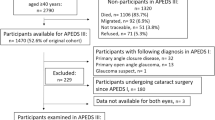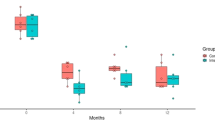Abstract
Background
To report the 15-year incidence rate of pseudo-exfoliation (PXF), PXF glaucoma and regional variation among rural participants in the Andhra Pradesh Eye Disease Study (APEDS) III.
Methods
This population-based longitudinal study was carried out at three rural study sites. Individuals of all ages who participated at baseline with a mean 15-year follow-up visit were included. Detailed Comprehensive ophthalmic examination was performed on all participants. The main outcome measure was development of PXF during the follow-up period in participants who were phakic in one or both eyes without PXF at baseline.
Results
Among 5395 participants, 5108 (94.6%) met the inclusion criteria. There were 93 (1.82%; 95% confidence interval (CI), 1.47–2.22) cases of incident PXF. Their median baseline age (1st, 3rd quartiles) was 51 (44, 59) years and the male: female ratio was 1.3:1. There was no case of incident PXF in participants aged <30 years at baseline. The incidence rate per 100 person years (95% CI) among all ages and those aged ≥30 years at baseline was 1.73 (1.64–1.82) and 3.73 (3.53–3.93), respectively. PXF material was located on iris as well as anterior surface of lens and it was often bilateral. Participants living in two study sites and increasing age were associated with the incidence of PXF. The 15-year incidence of PXF glaucoma (95% CI) in participants ≥30 years of age at baseline was 0.33% (0.14–0.66).
Conclusion
There is significant regional variation in incidence of PXF in south India which warrants further investigation.
This is a preview of subscription content, access via your institution
Access options
Subscribe to this journal
Receive 18 print issues and online access
$259.00 per year
only $14.39 per issue
Buy this article
- Purchase on Springer Link
- Instant access to full article PDF
Prices may be subject to local taxes which are calculated during checkout
Similar content being viewed by others
Data availability
The datasets generated during and/or analyzed during the current study are available from the corresponding author on reasonable request.
References
Challa P, Johnson WM. Composition of exfoliation material. J Glaucoma. 2018;27:S29–31.
Nazarali S, Damji F, Damji KF. What have we learned about exfoliation syndrome since its discovery by John Lindberg 100 years ago? Br J Ophthalmol. 2018;102:1342–50.
Ritch R, Schlötzer-Schrehardt U. Exfoliation syndrome. Surv Ophthalmol. 2001;45:265–315.
Miglior S, Bertuzzi F. Exfoliative glaucoma: new evidence in the pathogenesis and treatment. Prog Brain Res. 2015;221:233–41.
Karger RA, Jeng SM, Johnson DH, Hodge DO, Good MS. Estimated incidence of pseudoexfoliation syndrome and pseudoexfoliation glaucoma in Olmsted County, Minnesota. J Glaucoma. 2003;12:193–7.
Arnarsson A, Sasaki H, Jonasson F. Twelve-year incidence of exfoliation syndrome in the Reykjavik Eye Study. Acta Ophthalmol. 2013;91:157–62.
Vijaya L, Asokan R, Panday M, Choudhari NS, Ve Ramesh S, Velumuri L, et al. Six-year incidence and baseline risk factors for pseudoexfoliation in a South Indian population: the Chennai Eye Disease Incidence Study. Ophthalmology. 2015;122:1158–64.
Ekström C, Winblad von Walter L. Incidence and baseline risk factors for pseudoexfoliation in Sweden: a long-term follow-up study. Acta Ophthalmol. 2020;98:310–4.
Topouzis F, Founti P, Yu F, Wilson MR, Coleman AL. Twelve-year incidence and baseline risk factors for pseudoexfoliation: the Thessaloniki Eye Study (An American Ophthalmological Society Thesis). Am J Ophthalmol. 2019;206:192–214.
Dandona R, Dandona L, Naduvilath TJ, Nanda A, McCarty CA. Design of a population-based study of visual impairment in India: the Andhra Pradesh Eye Disease Study. Indian J Ophthalmol. 1997;45:251–7.
Khanna RC, Murthy GV, Marmamula S, Mettla AL, Giridhar P, Banerjee S, et al. Longitudinal Andhra Pradesh Eye Disease Study: rationale, study design and research methodology. Clin Exp Ophthalmol. 2016;44:95–105.
Choudhari NS, Khanna RC, Marmamula S, Mettla AL, Giridhar P, Banerjee S, et al. Fifteen-year incidence rate of primary angle closure disease in the Andhra Pradesh Eye Disease Study. Am J Ophthalmol. 2021;229:34–44.
Foster PJ, Buhrmann R, Quigley HA, Johnson GJ. The definition and classification of glaucoma in prevalence surveys. Br J Ophthalmol. 2002;86:238–42.
Vijaya L, George R, Arvind H, Baskaran M, Ve Ramesh S, Raju P, et al. Prevalence of primary angle-closure disease in an urban south Indian population and comparison with a rural population. The Chennai Glaucoma Study. Ophthalmology. 2008;115:655–60.
Senthil S, Garudadri C, Khanna RC, Sannapaneni K. Angle closure in the Andhra Pradesh Eye Disease Study. Ophthalmology. 2010;117:1729–35.
Khanna RC, Marmamula S, Pendri P, Mettla AL, Giridhar P, Banerjee S, et al. Incidence, incident causes, and risk factors of visual impairment and blindness in a rural population in India: 15-year follow-up of the Andhra Pradesh Eye Disease Study. Am J Ophthalmol. 2021;223:322–32.
Larsen JS. Senile exfoliation (pseudo-exfoliation, fibrillopathia epitheliocapsularis) of the lens capsule in a postmortem material. Microscopic investigation of 100 eyes. Acta Ophthalmol. 1969;47:676–84.
Hammer T, Schlötzer-Schrehardt U, Naumann GO. Unilateral or asymmetric pseudoexfoliation syndrome? An ultrastructural study. Arch Ophthalmol. 2001;119:1023–31.
Ringvold A, Blika S, Sandvik L. Pseudo-exfoliation and mortality. Acta Ophthalmol Scand. 1997;75:255–6.
Svensson R, Ekström C. Pseudoexfoliation and mortality: a population-based 30-year follow-up study. Acta Ophthalmol. 2015;93:162–4.
Sternfeld A, Luski M, Sella R, Zahavi A, Geffen N, Pereg A, et al. Diagnosis of pseudoexfoliation syndrome in pseudophakic patients. Ophthalmic Res. 2021;64:28–33.
Schmack I, Auffarth GU. Distribution of pseudoexfoliation material on anterior segment structures in human autopsy eyes after cataract surgery with intraocular lens implantation. Int Ophthalmol. 2016;36:341–6.
Pasquale LR, Jiwani AZ, Zehavi-Dorin T, Majd A, Rhee DJ, Chen T, et al. Solar exposure and residential geographic history in relation to exfoliation syndrome in the United States and Israel. JAMA Ophthalmol. 2014;132:1439–45.
Ringvold A, Blika S, Elsås T, Guldahl J, Brevik T, Hesstvedt P, et al. The Middle-Norway eye-screening study. I. Epidemiology of the pseudo-exfoliation syndrome. Acta Ophthalmol. 1988;66:652–8.
Kozobolis VP, Papatzanaki M, Vlachonikolis IG, Pallikaris IG, Tsambarlakis IG. Epidemiology of pseudoexfoliation in the island of Crete (Greece). Acta Ophthalmol Scand. 1997;75:726–9.
Funding
Hyderabad Eye Research Foundation, India, Lions Clubs International Foundation, SightFirst Research grant, USA, and Department of Biotechnology, Centre of Excellence (CoE) grant, India.
Author information
Authors and Affiliations
Consortia
Contributions
NSC was responsible for data analysis, drafted the manuscript, approved the final version and agreed to be accountable for all aspects of the work in ensuring that questions related to the accuracy or integrity of any part of the work are appropriately investigated and resolved. RCK conceived and designed the work that led to the submission, acquired data, and played an important role in interpreting the results, revised the manuscript, approved the final version and agreed to be accountable for all aspects of the work in ensuring that questions related to the accuracy or integrity of any part of the work are appropriately investigated and resolved. CG played an important role in interpreting the results, revised the manuscript, approved the final version and agreed to be accountable for all aspects of the work in ensuring that questions related to the accuracy or integrity of any part of the work are appropriately investigated and resolved. All the remaining authors acquired data, played a role in interpreting the results, revised the manuscript, approved the final version and agreed to be accountable for all aspects of the work in ensuring that questions related to the accuracy or integrity of any part of the work are appropriately investigated and resolved.
Corresponding author
Ethics declarations
Competing interests
The authors declare no competing interests.
Additional information
Publisher’s note Springer Nature remains neutral with regard to jurisdictional claims in published maps and institutional affiliations.
Supplementary information
Rights and permissions
Springer Nature or its licensor holds exclusive rights to this article under a publishing agreement with the author(s) or other rightsholder(s); author self-archiving of the accepted manuscript version of this article is solely governed by the terms of such publishing agreement and applicable law.
About this article
Cite this article
Choudhari, N.S., Khanna, R.C., Marmamula, S. et al. Regional variation in the incidence of pseudo-exfoliation in the Andhra Pradesh Eye Disease Study (APEDS). Eye 37, 1704–1710 (2023). https://doi.org/10.1038/s41433-022-02226-9
Received:
Revised:
Accepted:
Published:
Issue Date:
DOI: https://doi.org/10.1038/s41433-022-02226-9



